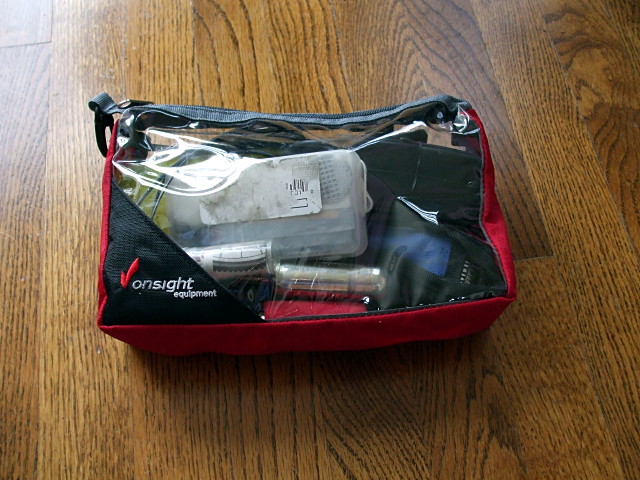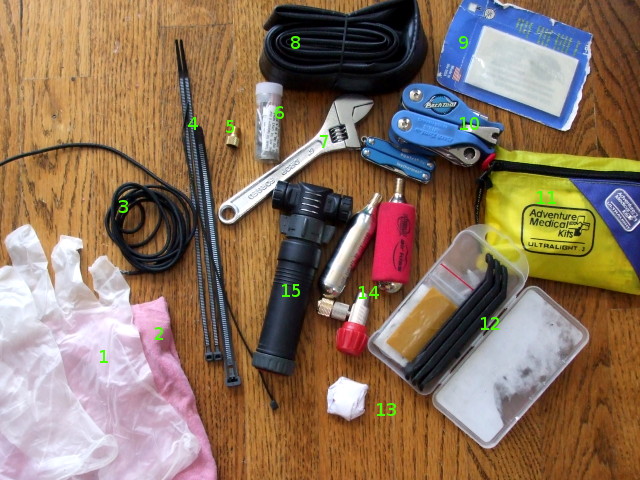
I only started cycling longer distances about 8 years ago, after a lifetime of confining myself to Toronto’s streets and trails. Breakdowns weren’t a huge issue in the city because in the worst case, I was always within an hour’s walk of the subway. But as I started riding farther and farther out of the city, it became increasingly obvious that I needed to be prepared for flats and other common bike ailments. This is especially true because my longer rides are almost always solo.
I started with the bare minimum of a patch kit, tire levers, and a pump before gradually adding items based on actual problems that I’d had or encountered other people having. Eventually, I decided to package it all up into a bag that I could just move from mountain bike to road bike. And then I just built up three separate kits: one each for my commuting, mountain, and road bikes. They each have slightly different requirements and it was easier in the end to have dedicated kits for each than to repack a single kit for each trip.
The interesting thing I’ve found about having a kit is that I use it to help others more often than I need it myself. I’ve helped other riders get back on the road from problems as simple as a flat tire and unexpected as loose handlebars. I always stop to ask cyclists at the side of the road if they need help. Even if they wave me off, I’ll frequently hang around until they finish the repair, offering moral support if nothing else.
Let’s take a look inside my kit.
This is the kit for my mountain bike, which is used almost exclusively to get me to various destinations outside of the city. The bike carries me both on- and off-road as far as Niagara Falls, Hamilton, Lake Simcoe, Port Perry, and Whitby, and I like having enough with me to get me at least as far as the nearest GO station. The entire kit weighs a touch less than 3 lb. Some would scoff at carrying the extra weight, but it provides me with peace of mind and the weight penalty is far less than the water and food I carry for a typical day-long ride. This is way more than I’d want to carry for short rides in the city, but I wouldn’t head into the countryside without it.

- Latex gloves. Working on a chain or wheel can be a dirty job. I always use gloves in the shop and added them to my road kit a couple of years ago after a bit of messy roadside work following a broken derailleur cable.
- Clean rag, for much the same reason as gloves. Plus, it can be used as a bandana or tourniquet, for wiping parts down, or for washing up in a stream. Nothing magical here, just a piece of an old t-shirt.
- Length of thin bungee cord. Bungee is handy for all kinds of things, and there’s enough here to lash something to the bike or hold a pack closed.
- Selection of zip ties, including one that can be released and re-used any number of times. Zip ties are incredibly handy for holding a derailleur while repairing a chain, tying down wayward cables, and securing broken parts. They also make excellent temporary substitutes for missing bolts.
- Presta->schrader valve adapter. My mountain bike doesn’t have presta valves, but I started carrying an adapter this year so that I could lend a hand with people on road bikes. Both my pump and inflator work with presta valves without an adapter, but I find presta valves prone to damage, especially when working in the field. A busted valve in the shop is one thing, but a busted valve on your only spare tube 100 km away from home is quite another.
- Kevlar emergency spoke. This can be used to temporarily shore up a wheel that has broken or missing spokes. I’ve never had to use it in practice, but had a long and glorious history with mangled wheels for many years.
- Adjustable wrench. It’s small, cheap, and light. I don’t really need it for anything on my bike, but it can provide extra leverage or an extra hand for some repairs. It also makes a passable hammer, prybar, and general all-around brute force tool.
- Spare tube. ‘Nuff said.
- Tire boots. If you have a tire blowout rather than just a flat, you can’t just put in a new tube and expect everything to be okay, especially if the blowout is at the tire bead or on the sidewall. These boots will hold a blown tire together for long enough for you to ride home or to a shop. It’s not as good as carrying an extra tire with you, but they’re lighter and more portable.
- Multi-tools. I have one bike-specific tool with hex wrenches, spoke wrenches, and screwdrivers that fit virtually everything that turns, tightens, or adjusts on the bike. It also has a chain tool to repair broken chains. I also carry one small general multi-tool that has pliers, wire cutters, and a couple of blades and files. The Boy Scout in me is always prepared.
- Emergency medical kit. Bandages, moleskin, gauze, disinfectant, After Bite. It’s not enough for a full-on case of road rash, but it’s good enough for the more typical scrapes and stings I may get when crashing down unfamiliar trails or traversing open fields.
- Tube repair kit. In addition to tire levers and a spare tube, I carry patches, sandpaper, and glue. I’d always rather repair a tube than replace it. Either way, I have had virtually no flat tires since starting to use Mr. Tuffy tire liners a few years ago.
- Money. This little bundle contains enough coin for a small snack and a phone call home, as well as a couple of TTC tokens for when I get closer to home but am just too tired to continue. I also carry a separate wallet with money and ID, but again, my inner Boy Scout wants to be prepared.
- CO2 inflator and air cartridges. Incredibly handy for quickly inflating repaired tubes. Who wants to spend 10 minutes madly hammering away with a mini-pump after fixing a flat? I’ve done it enough times to know that I don’t want to do it any more.
- A mini pump. CO2 cartridges and a pump? Yep. Unlike cartridges, a pump doesn’t run out of air. It’s a pain to use compared to an inflator, but essential to have as a backup, in my opinion.
What’s not in my kit? The most glaring omission I can think of is spare derailleur and brake cables. I break 2-3 cables every year, but I can always limp home with one brake or three gears. Even if I did carry cables with me, I’d hate to try to tune a rear derailleur with a new cable at the side of the road anyway. Brakes would be easier.
My commuting kit is much lighter: its functionality is limited to just fixing flat tires since my commute never takes me more than about a 10-minute walk from the subway. The kit for my road bike is somewhere between these two: lighter than the mountain bike kit but with similar breadth.
Of all of the breakdowns I’ve had over the years, only one would be beyond fixing with my current kit: while riding to work last winter, I had some kind of problem with my hub where my pedals were spinning freely but not transferring any power to the rear wheel. Think of what it’s like when your chain falls off, but everything was properly connected. I ended up schluffing the last kilometre to work and dropping my bike at the shop near the office. But in an emergency, I probably could have zip tied the cassette to the rear wheel, turning the bike into a fixie for the rest of the ride home. I would have had to get underway gingerly and probably walk up hills, but it would have been better than nothing.
A few tips if you’re building your own kit:
- Buy light but don’t skimp on quality. Saving $2 on tire levers that break when you’re in the field is false economy.
- Test all of your tools at home. Know how to use them and make sure that they all work the way you expect them to.
- Buy appropriate tools for your bike. If you have a multi-tool, confirm that it will actually loosen or tighten everything on your bike likely to need loosening or tightening. Nothing is worse than triumphantly hauling out your tools on the road to fix some little problem, only to discover that you don’t have the right size hex wrench.
- Take your kit with you, even if it consists only of a phone to call for help.
I saw some awesome tire levers at Mellow Johnny’s in Austin. They were very light metal (titanium I think) and looked pretty nice. I’ve had way too many plastic ones break, but I didn’t get a set because they cost $30 US.
I volunteered as a mechanic for the ride to conquer cancer this year. I took along my MEC shop tire levers, and they were quite handy to have, as 90% of the problems were flat tires.
I might get some of those tire liners. I’ve heard nothing but good things.
I’ve always wanted to get some decent metal levers, but haven’t yet made the leap.
I can’t recommend tire liners enough. They won’t prevent every flat, but they make a big difference.